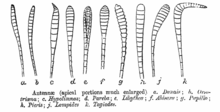| Revision as of 06:33, 30 May 2006 editAshLin (talk | contribs)Autopatrolled, Extended confirmed users, Pending changes reviewers, Rollbackers32,664 edits Adding an image← Previous edit | Revision as of 16:16, 8 June 2006 edit undoAlexei Kouprianov (talk | contribs)Extended confirmed users693 edits + antennomeresNext edit → | ||
| Line 8: | Line 8: | ||
| In ]s, ]s on the antennae bind to ] molecules, including ]s. The ] that possess these receptors signal this binding by sending ]s down their ]s to the ] in the ]. From there, neurons in the antennal lobes connect to ] that identify the odour. | In ]s, ]s on the antennae bind to ] molecules, including ]s. The ] that possess these receptors signal this binding by sending ]s down their ]s to the ] in the ]. From there, neurons in the antennal lobes connect to ] that identify the odour. | ||
| The three basic segments of insect antennae are the ''scape'' (base), the ''pedicel'' (stem), and finally the ''flagellum'', which comprises many units known as ''flagellomeres''. | The three basic segments of insect antennae are the ''scape'' (base), the ''pedicel'' (stem), and finally the ''flagellum'', which comprises many units known as ''flagellomeres''. In the groups with more uniform antennae (e. g. ]), all segments are called ''antennomeres''. | ||
| ] | ] | ||
Revision as of 16:16, 8 June 2006
For other uses, see Antenna.
Antennae (singular antenna) are paired appendages connected to the front-most segments of arthropods. In crustaceans, they are biramous and present on the first two segments of the head, with the smaller pair known as antennules. All other arthropod groups, except chelicerates and proturans which have none, have a single, uniramous pair of antennae.
Antennae are jointed, and generally extend forward from the head. They are sensory organs, although the exact nature of what they sense and how they sense it is not always clear. It appears that their function may include sensing touch, air motion, heat, vibration (sound), and olfaction (smell or taste).
In insects, olfactory receptors on the antennae bind to odour molecules, including pheromones. The neurones that possess these receptors signal this binding by sending action potentials down their axons to the antennal lobe in the brain. From there, neurons in the antennal lobes connect to mushroom bodies that identify the odour.
The three basic segments of insect antennae are the scape (base), the pedicel (stem), and finally the flagellum, which comprises many units known as flagellomeres. In the groups with more uniform antennae (e. g. Diplopoda), all segments are called antennomeres.
